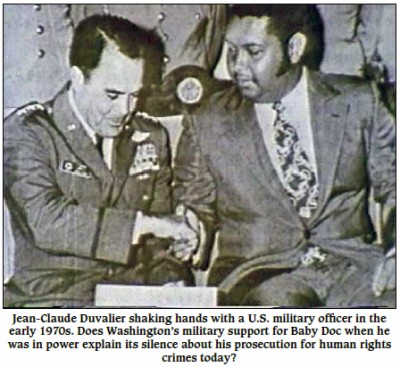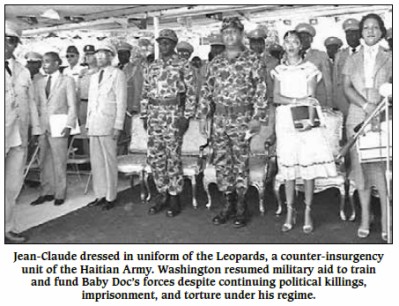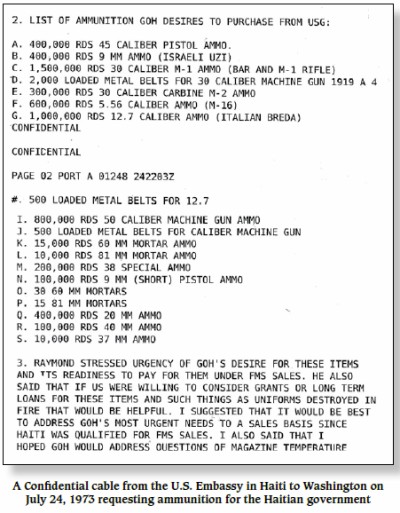|
by Kim Ives

A chorus of outrage is building against
former Haitian president Jean-Claude “Baby Doc” Duvalier as he
sits in the dock of a Haitian court, charged with crimes against
humanity during his 15-year rule. However, the U.S. government
remains strangely and completely silent. A 40-year-old trove of
diplomatic cables, newly unearthed by WikiLeaks, helps explain
why.
Around midnight in the early morning hours
of Jul. 23, 1973, a fire broke out in the packed armory of
Haitian dictator Jean-Claude Duvalier’s National Palace.
Almost immediately,
“President-for-Life” Duvalier and his Army Chief of Staff,
General Claude Raymond, telephoned the U.S. Embassy’s Deputy
Chief of Mission, Thomas J. Corcoran, to tell him about the fire
and ask for U.S. assistance in putting it out.
The destruction of Haiti’s
large weapons cache became, in the following days, the perfect
excuse to resume the sale of military weapons as well as
military aid and training to the Duvalier dictatorship, after it
had been halted during the 1960s under the notorious regime of
François “Papa Doc” Duvalier.
Haïti Liberté has been
able to reconstruct a clear picture of this pivotal historical
moment thanks to a new website constructed by WikiLeaks called
the Public Library of U.S. Diplomacy or PlusD. The site
enables searching of over 1.7 million State Department cables
from 1973 to 1976 which had been declassified and stored in the
U.S. National Archives, but which were all but inaccessible due
to the form in which they were kept.
Haïti Liberté is one of
18 media partners worldwide to which WikiLeaks provided
exclusive access to the PlusD search engine in early March,
prior to its unveiling for public use on Apr. 8. This article is
one of several which Haïti Liberté is planning based on
the cables from the 1970s.
“General Raymond and President
Duvalier telephoned me at 0245 [2:45 a.m.] to report fire in
National Palace and to request fire extinguishers which we
dispatched,” Corcoran explained in a
Jul. 23, 1973 Confidential
cable. “At about 0325 Foreign Minister [Adrien] Raymond informed
me fire was spreading throughout ammunition storage including
small arms and artillery ammo and beyond control of local
firefighting facilities.”
The U.S. immediately deployed a
team of nine military fire-fighters from its naval base at
Guantanamo Bay, Cuba. They “acted without regard for their
personal safety in fighting the fire in an area in which a large
variety of explosive ordnance had been stored and exposed to
intense heat over a period of hours,” Corcoran wrote in a
Jul.
27, 1973 cable commending their valor.
On Jul. 24, 1973, the day
immediately after the fire, Foreign Minister Raymond “summoned”
Corcoran and “presented [him] a list of ammunition and mortars
which GOH [the Government of Haiti] urgently desires to purchase
for the ‘maintenance of public peace, the tranquillity of
families and protection of property.’”
Adrien
Raymond, “on instructions of
President Jean-Claude Duvalier,”
urgently requested millions of
rounds of ammunition for Haiti’s Army. Among the largest items
on the long list were 1.5 million 30 caliber rounds for M-1
rifles, 800,000 rounds for 50 caliber machine guns, 600,000 5.56
mm rounds for M-16 automatic rifles, and 400,000 9mm rounds for
Uzi submachine guns. Duvalier also wanted dozens of mortars and
tens of thousands of mortar shells.
The Haitian Army had never
waged war against any enemy other than the Haitian people.
Nonetheless, Corcoran and the U.S. Embassy’s military attaché
called the list “reasonable” and “strongly recommend[ed]
approval of sale,” the cable said.
In the following weeks,
Haiti’s
military laundry list would grow in length and breadth, asking
not just for more ammunition but also for weapons and supplies,
including 38 and 45 caliber handguns, M-1 rifles, M-2 carbines,
30 and 50 mm machine guns, 60 and 81 mm mortars, grenade
launchers, cartridge belts, and high-capacity ammo clips.
On Jul. 25, 1973, Corcoran sent
another Confidential cable where he encouraged the State and
Defense Departments “to take quickest possible action” and make
an “extraordinary effort to expedite paper work” to reply
favorably to Duvalier’s request because, among other reasons,
“the Haitian Government is prepared to pay for its requirements,
and there is no reason why the US should not get the sale.” (Not
long before, Haiti had bought weapons from Israel and Jordan, as
well as “from ‘fast-buck’ private arms dealers,” according to
Corcoran.)
Furthermore, Duvalier’s
“request seems an excellent opportunity to strengthen U.S.
influence even more with the GOH... and to win the goodwill of
individual Haitian military officers,” Corcoran wrote in the
cable.
The U.S. had curtailed military
aid and sales to Haiti after François Duvalier expelled a U.S.
Marine Mission from the country in 1963. But following Papa
Doc’s death in April 1971, his son “Baby Doc” inherited the
“Presidency for Life” and began to repair and improve relations
with the U.S., from which he wanted aid and investment.
Indeed, the sale was approved
and the “GOH delivered to [the U.S.] Embassy Sept. 19, 1973
check no. 163211 drawn on National Bank of Republic of Haiti
same date payable to USAFSA [United States Army Forces in South
America] in amount of dollars $273,411.40,” Corcoran wrote in a
Sep. 19, 1973 cable. The sale was equivalent to over $1.4
million in 2013 dollars.
Nonetheless, the U.S. was
worried about appearances, and Corcoran wrote in an
Aug. 17,
1973 cable that “no, repeat no, USG [U.S. Government] aircraft
delivery [is] contemplated.” Instead the guns and ammo arrived
on two Pan Am charter flights on Sep. 26 and Oct. 1, 1973, the
cables show.
Around the same time, the U.S.
Embassy was also negotiating with the regime for the sale of six
“Cadillac-Gage commando armored cars,” two of which would be
used for the Leopards, an elite counter-insurgency unit of the
Haitian army.
The U.S. wanted to proceed with
the sale of just four cars, the request for which had been made
in June, before the armory fire. The Embassy wanted to finish
with the pending ammunition and weapons sale “before addressing
[the] problem of [the] other two cars,” but Duvalier had
threatened to take his business elsewhere, namely to the French,
Corcoran explained in an
Aug. 31, 1973 cable. He recommended
that “that State/Defense [Departments] reply gently to implied
threat to transfer order to French firm that financial outlay of
that sort to French company at time U.S. giving economic
assistance to Haiti might raise all sorts of questions.”
Military aid was also being
resumed in this period. The “Embassy can understand Haiti's
exclusion from the list of countries eligible for grant military
training in the 1960s, owing to political conditions prevailing
at that time,” Corcoran argued in a
Nov. 23, 1973 cable.
“However, times in Haiti have changed. The country has a new,
young president moving in some positive new directions.” He
claimed that “in the past few years, repression has been
markedly and genuinely eased in Haiti” and that the government
was showing “political restraint” and “a clear desire to do more
for the economic development of the country.”
Most importantly, “in
international organizations, the new government in Haiti has
been a dependable, good friend of the U.S., for whatever that is
worth,” Corcoran wrote. “All these are positive tendencies which
it seems to us should be encouraged.”
This was “why we believe some
grant military training for Haiti is very much in our
interests,” because, among other things, it provided “the
opportunity to establish some influence with the whole
generation of younger Haitian military officers who know nothing
of the U.S..”
“In sum,” Corcoran concluded,
“it seems illogical that Haiti... should still be singled out
for total exclusion from grant training programs enjoyed by
nearly every other nation of the hemisphere for many years --
training which will contribute substantially to advancing a
number of our important interests in the region.”
Indeed, U.S. military aid was
resumed, specifically to train units like the Leopards, which
was described by the National Coalition for Haitian Rights in a
1986 report as“particularly brutal in dealing with civilians.”
Researcher Jeb Sprague explains
in his new book “Paramilitarism and the Assault on Democracy in
Haiti” that the Leopards were trained and equipped “by former
U.S. marine instructors who were working through a company (Aerotrade
International and Aerotrade Inc) under contract with the CIA and
signed off by the U.S. Department of State. Baby Doc himself
trained with the Leopards, forming particularly close bonds with
some in the force. A U.S. military attaché bragged that the
creation of the force had been his idea. Aerotrade’s CEO, James
Byers, interviewed on camera, explained that he had ‘no trouble
exporting massive quantities of arms. The State Department
signed off on the licenses, and the CIA had copies of all the
contracts. M-16 fully automatic weapons, thousands and thousands
of rounds of ammunition, patrol boats, T-28 aircraft, Sikorsky
helicopters. Thirty-caliber machine guns. Fifty-caliber machine
guns. Mortars. Twenty-millimeter rapid-fire cannons. Armored
troop carriers.’ A handful of veterans from this force would
later serve, off and on, as key figures in various paramilitary
forces” which the U.S. used to carry out and maintain coups
against the governments of President Jean-Bertrand Aristide in
1991 and 2004.
Jean-Claude Duvalier, who
returned to Haiti in January 2011 from a 25 year golden exile in
France, is now technically under house arrest in Haiti. An
appeals court is receiving testimony and evidence from witnesses
charging that Duvalier must be tried for crimes against
humanity. Haitian and international human rights groups
have
documented hundreds of cases of torture and extrajudicial
killings and imprisonments under Baby Doc’s 15 year rule from
1971 to 1986. In January 2012, investigating judge Carves Jean
dismissed the human rights charges against Duvalier, arguing
that the statute of limitations had expired. The appeals court
may overrule that decision.
About 7,000 of the 1.7 million
secret diplomatic cables from 1973 to 1976 deal with Haiti. The
cables “were reviewed by the United States Department of State's
systematic 25-year declassification process,” WikiLeaks explains
on its PlusD website. The cables were then “either declassified
or kept classified with some or all of the metadata records
declassified” and then “subject to an additional review by the
National Archives and Records Administration (NARA).” Those
cables released then “ were placed as individual PDFs at the
National Archives as part of their Central Foreign Policy Files
collection.”
However, the cables in their
PDF form “are actually quite difficult to get to for the general
public,” explained Kristinn Hrafnsson, a spokesperson for
WikiLeaks and a former Icelandic investigative journalist, to
Democracy Now on Apr. 8. “It’s very hard to access them. So, in
our view, the inaccessibility and the difficulty of accessing
them is a form of secrecy... so we found it important to get it
to the general public in a good searchable database.”
Twenty-five year old U.S.
classified documents are supposed to be reviewed and
declassified every year. The public should therefore be able to
view classified documents as late as 1988. However, the
declassification process has only been done until 1976, meaning
it is 12 years behind schedule.
Another reason that WikiLeaks
established the PlusD database is because “there has been a
trend in the last decade and a half to reverse previously
declassified policy,” Hrafnsson explained. “A policy set out,
for example, by Clinton in the mid-'90s was, a few years later
under Bush, is reversed. It was revealed in 2006, for example,
that over 55,000 documents that were previously available had
been reclassified by the demand of the CIA and other agencies.
And it is known that this program continued at least until 2009.
So, it is very worrying when the government actually starts
taking back behind the veil of secrecy what was previously
available.” The PlusD database cannot be snatched back behind
the veil.
The 1973 to 1976 cables cover
the period that infamous Secretary of State Henry Kissinger was
in office under both Presidents Richard Nixon and then Gerald
Ford. WikiLeaks has therefore dubbed the trove the “Kissinger
Cables.” (After he left his post, Kissinger and his wife visited
Duvalier in Haiti.)
In 2011, WikiLeaks provided
Haïti Liberté exclusively with about 2,000 secret U.S.
cables related to Haiti dating from 2003 to 2010. They came from
a larger 250,000-cable trove, known as “Cablegate,” which was
anonymously provided to WikiLeaks by U.S. Corp. Bradley Manning.
He has been imprisoned in “pre-trial detention” some 1,050 days
under torture-like conditions. He is being court-martialed and
may be charged with treason, which can carry the death penalty.
There is a world-wide movement denouncing the U.S. government’s
treatment of Manning, who also gave to WikiLeaks
a video showing
a U.S. Apache helicopter gunning down 12 people in Iraq in
2007, including two Reuters journalists.
With the release of PlusD and the “Kissinger
Cables,” WikiLeaks has once again provided journalists and
people around the world a glimpse into the shrouded world of
U.S. foreign policy. While Top Secret cables are not available,
the thousands of formerly Secret and Confidential cables from
the 1970s provide a clear look into how the State Department
fashioned its rationales for many outrageous policies during
that period, like the resumption of military aid to an
unelected, corrupt, and repressive dictator like Jean-Claude
Duvalier. |